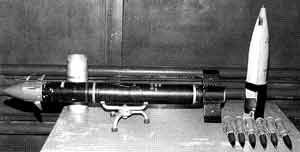| Designation: | 9K116-1 Bastion / AT-10 |
 |
|---|---|---|
| Manufacturer: | KBP Instrument Design Bureau | |
| Product type: | Weapons & Weapon Systems | |
| Name: | Anti-tank guided missile launcher |
The US designated AT-10 (industrial index number 9M117M, named Bastion, meaning a bastion) began development by the Tula KBP Design Bureau for Instrument Building in the late seventies and entered service in 1983.
It is a single-piece third-generation 100 mm calibre laser beam-riding projectile for use with the 100 mm noted that T-55 tanks built to the AT-10 system configuration have been fitted with the Volna (Russian Federation and Associated States (CIS)), Merida (Polish) or Kladivo (Czech and Slovakian) fire-control systems.
T-55 variants known to be fitted with the system include: T-55M, T-55AM, T-55M-1, T-55AM-1, T-55D, T-55D-1, T-55MV, T-55AMV, T-55AM2PB (all RFAS models), T-55AM2B (produced in the former Czechoslovakia) and T-55AM2P (produced in Poland).
The principal components of the 9K116 beam-riding
(1) the 3UBK10M-1 guided round (comprising the 19.4 kg 9M117 missile mounted within a cartridge case)
(2) an onboard vehicle guidance system which comprises:
(a) a 1K13 day/night telescopic sight (with integral 1K13BZ laser emitter) to replace the T-55 series' standard TPN-1M-22-1 telescopic Infra-Red (IR) sight. The sight is vertically stabilised with its line of sight slaved to the stabilised 100 mm gun for the the sighting system is activated to switch the main armament stabilisation system off and reduce the maximum turret traverse speed down so as to avoid any distortion effects. After the 'system ready' sign comes on the gunner can fire the missile. The 9M117M missile is fired electrically as in the case of the standard 100 mm ammunition types. The missile's built-in battery is started and the gyroscope run up. After 1.5 seconds an ejection charge in the cartridge is ignited and the missile leaves the barrel. Then, after the base has been jettisoned, the four rear-mounted aerodynamic stabilising fins are unfolded. The four forward-mounted control fins are also deployed. The sustainer rocket motor cuts in and burns for approximately 6 seconds. After firing, the commander's laying device is turned off and the laser is activated to emit the modulated IR laser guidance beam. The missile flies automatically within a guidance zone formed by this projected beam. All the gunner has to do during the remainder of the engagement is to keep his sight on the target until the missile has impacted. During the whole of the semi-automatic guidance phase the sightline is independently stabilised from the gun in both azimuth and elevation. A modulator encodes the laser beam in such a fashion that each reference point of the guidance zone is given a precisely timed sequence of frequencies. The correlation between the duration of the different frequencies is determined by the position of each point within the guidance zone. The 6 m diameter of the guidance zone is kept constant throughout the flight by progressively zooming the beam. A receiver in the rear section of the missile transmits information on the flight position within the guidance zone to the onboard guidance system which then transmits flight control commands to the four forward-mounted flip-out control surface fins. The 9M117M is aerodynamically stabilised by its four rear-mounted pop-up stabilisers (b) a 9S381 voltage converter unit
(c) a modified STP-2A stabilisation system (to replace the standard STP-2 system)
(d) an L4 IR searchlight to replace the L-2G type. When the tank is static the system can be used to
engage moving and stationary targets, static positions or slow moving aerial targets. Effective engagement limits are stated to be from 100 to 4,000 m, with the weapon having a flight time of 13.5 seconds to 4,000 m. In the event of a miss, a self-destruct device automatically destroys the HEAT warhead within 26 to 41 seconds of firing. Overall weight is 27 kg.
Standard combat load for the T-55 is six AT-10s.
Early production missiles had a single HEAT warhead, but a version with a tandem HEAT warhead is now available with the missile being designated the 9M117M.
In 1999, it was announced that a new round with a maximum range of 5,500 m had been developed.
- 100 mm 9K116 Kastet
The 100 mm Kastet guided round is similar to the Bastion variant but is designed to be fired from the 100 mm MT-12 towed anti-tank gun. The gun must have a special laser designator system mounted nearby in order to guide the Kastet round. As far as it is known this version has not been exported. This missile has a maximum range of 5,000 m whereas the tank launched missiles have a maximum range of 4,000 m. The complete round is designated the 3UBK10M.
- 100 mm 9K116 system for the BMP-3 ICV
The same 9M117M missile is used but the round has a significantly different propellant casing because of the ballistics of the 100 mm 2A70 gun used on the BMP-3. The round designation is 3UBK10M3 and the basic load is six rounds, which are carried in a special compartment. The vehicle's autoloader has been specifically designed to load both these guided weapons and conventional 100 mm rounds.
More recently a version with a maximum range of 5,500 m has been introduced.
In production. In service with the RFAS and some other countries.
- T-55 medium tank (100 mm gun/missile launcher -
- RFAS armies, Naval Infantry and other unspecified
countries)
- BMP-3 ICV (100 mm gun/missile launcher - RFAS armies, Naval Infantry, Cyprus, Kuwait, South Korea and United Arab Emirates).
|
||||||||||||
|
||||||||||||||||||
|
|||||||||
 |
 |
